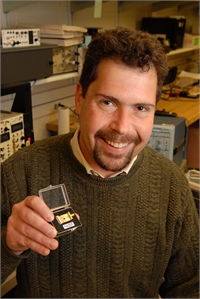Robert Lutwak
Title: Precise Robust Inertial Guidance for Munitions: Navigating in a GPS-free World
 Robert Lutwak, Defense Advanced Research Projects Agency
Robert Lutwak, Defense Advanced Research Projects Agency
Tuesday, February 23, 2016, 09:00
Room: Sand Dollar
Abstract: The advent of precision-guided munitions has forever changed the tactics, strategies, and politics of military engagement. The technological success of precision munitions, guided by global navigation satellite systems (GNSS), provides the basis for an international consensus in which indiscriminate bombing and collateral civilian casualties are synonymous with barbarism. Threats to the integrity of GNSS navigation, such as jamming and spoofing, create not only a technical challenge, but also a modern ethical and political quandary, extending beyond the tactical implications of inaccuracy. It is therefore incumbent upon the inertial sensor community to develop navigation technology which enables munitions accuracy that meets or exceeds that of GNSS in a world where GNSS is increasingly unavailable or unreliable. Precise munitions navigation is a challenging operational environment for inertial sensors, particularly due to extreme motional dynamics, combined with extraordinary limitations on cost, size, weight, and power (CSWaP). Over the past decade, the DARPA Micro-Technology for Position, Navigation, and Timing (micro-PNT) program developed low-CSWaP inertial sensors as a backup or “flywheel” PNT solution for GNSS augmentation, validation, and holdover in obfuscated environments. New programs, such as the Precise Robust Inertial Guidance for Munitions (PRIGM) program, seek to ruggedize and deploy devices developed under micro-PNT and to extend the performance to support longer and more dynamic mission scenarios. In addition to maturing microelectromechanical systems (MEMS) and atomic technologies developed under micro-PNT, PRIGM is exploring new sensing modalities and architectures, including those enabled by integrated photonics and by the tight integration of photonic and MEMS technologies. This presentation will provide a review of the technologies developed under the micro-PNT program as well as an introduction to new technologies being explored under the PRIGM program.
Stephen Breit
Title: Predicting the Future of the Commodity MEMS Inertial Sensor Design and Manufacturing
 Dr. Stephen Breit, Vice President of Engineering, Coventor
Dr. Stephen Breit, Vice President of Engineering, Coventor
Wednesday, February 24, 9:00 AM
Room: Sand Dollar
Abstract: Coventor has been developing tools for modeling MEMS inertial sensors for nearly two decades. Through addressing the modeling challenges of leading MEMS companies and R&D organizations around the world, our tools have gotten increasingly sophisticated and we have gained visibility on trends that could lead to disruptive changes in the commodity MEMS inertial sensor business. The trends include commoditization of MEMS process technology, consolidation of advanced semiconductor technology, More-than-Moore integration, and the Internet of Things (IoT). These trends are motivating industry efforts toward a transition similar to the one that occurred in the CMOS industry: from integrated device manufacturers to a fabless/foundry business model. For MEMS as for CMOS, the transition will require a design automation flow that provides a platform for process design kits (PDKs) that foundries can supply to their fabless customers. We’ll describe the challenges of MEMS design automation in comparison to electronic design automation. Then we’ll describe progress toward a design automation flow and PDKs for MEMS inertial sensors based on a proven fabrication process. The uses of this inertial sensor design and manufacturing platform could go in several directions. We’ll conclude with a speculation on the direction that could lead to greatest business success for foundries and their customers.
John Kitching
Title: Chip-Scale Atomic Devices: From Clocks To Brain Imaging And Beyond
 Dr. John Kitching, Group Leader & Fellow, NIST
Dr. John Kitching, Group Leader & Fellow, NIST
Thursday, February 25, 2016 09:00
Room: Sand Dollar
Abstract: Over the last decade, miniature instruments based on microfabricated alkali vapor cells have emerged as a compelling technology for achieving small size and low-power operation while retaining much of the high precision afforded by the use of atomic spectroscopy.